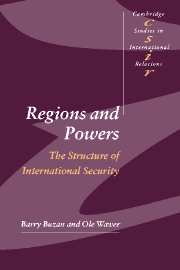Book contents
- Frontmatter
- Contents
- List of illustrations
- Preface
- List of abbreviations
- 1 Patterns of regional security during the Cold War
- 2 Patterns of regional security post-Cold War
- Part I Introduction: developing a regional approach to global security
- Introduction
- 1 Theories and histories about the structure of contemporary international security
- 2 Levels: distinguishing the regional from the global
- 3 Security complexes: a theory of regional security
- Conclusions
- Part II Asia
- Part III The Middle East and Africa
- Part IV The Americas
- Part V The Europes
- Part VI Conclusions
- Glossary
- References
- News media
- Index of names
- General Index
- CAMBRIDGE STUDIES IN INTERNATIONAL RELATIONS
2 - Levels: distinguishing the regional from the global
Published online by Cambridge University Press: 05 December 2009
- Frontmatter
- Contents
- List of illustrations
- Preface
- List of abbreviations
- 1 Patterns of regional security during the Cold War
- 2 Patterns of regional security post-Cold War
- Part I Introduction: developing a regional approach to global security
- Introduction
- 1 Theories and histories about the structure of contemporary international security
- 2 Levels: distinguishing the regional from the global
- 3 Security complexes: a theory of regional security
- Conclusions
- Part II Asia
- Part III The Middle East and Africa
- Part IV The Americas
- Part V The Europes
- Part VI Conclusions
- Glossary
- References
- News media
- Index of names
- General Index
- CAMBRIDGE STUDIES IN INTERNATIONAL RELATIONS
Summary
The how and why of distinguishing the regional from the global level
Any coherent regionalist approach to security must start by drawing clear distinctions between what constitutes the regional level and what constitutes the levels on either side of it. Lake and Morgan (1997c) draw the distinction between regional and global, but then use definitions of region that effectively conflate these two levels. The fact that the regionalist approach features a distinct level of analysis located between the global and the local is what gives RSCT its analytical power. Distinguishing the regional from the unit level is not usually controversial. Units (of whatever kind) must have a fairly high degree of independent actor quality. Regions, almost however defined, must be composed of geographically clustered sets of such units, and these clusters must be embedded in a larger system, which has a structure of its own. Regions have analytical, and even ontological, standing, but they do not have actor quality. Only exceptionally does this distinction become problematic, as for example in the case of the European Union (see ch. 11). Mostly, the differentiation of units and regions is fairly straightforward.
Distinguishing the regional from the global is less straightforward. The easy part is that a region must obviously be less than the whole, and usually much less. The tricky bit is actually specifying what falls on which side of the boundary.
- Type
- Chapter
- Information
- Regions and PowersThe Structure of International Security, pp. 27 - 39Publisher: Cambridge University PressPrint publication year: 2003

